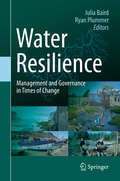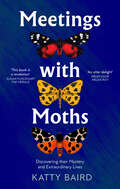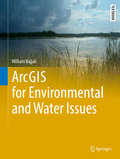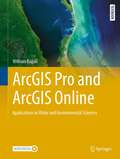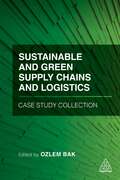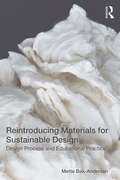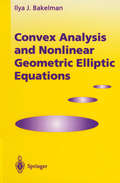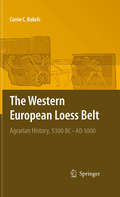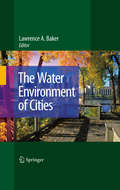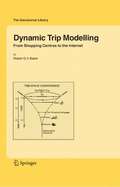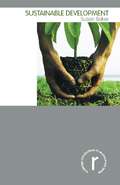- Table View
- List View
Water Resilience: Management and Governance in Times of Change
by Julia Baird Ryan PlummerThis book synthesizes current knowledge and understanding of management and governance in the context of water resilience; advances theory through synthesis of research and experiences from a variety of disciplinary perspectives. The book highlights the implications of theory and experience for innovation in practice and policy; and it explores frontiers and future research. The book further addresses the need for a consolidated, interdisciplinary approach to the theoretical advances and practical implications of water resilience for academics, resource managers, aid organizations, policy makers and citizens.
Meetings with Moths: Discovering Their Mystery And Extraordinary Lives
by Katty BairdMossy greens, conker browns, cream, chocolate and deepest black; add stripes, swirls and splotches and you have some of the most striking wildlife Britain has to offer.
Spin Glasses: Criticality and Energy Landscapes (Springer Theses)
by Marco Baity JesiThis thesis addresses the surprising features of zero-temperature statics and dynamics of several spin glass models, including correlations between soft spins that arise spontaneously during avalanches, and the discovery of localized states that involve the presence of two-level systems. It also presents the only detailed historiographical research on the spin glass theory. Despite the extreme simplicity of their definition, spin glasses display a wide variety of non-trivial behaviors that are not yet fully understood. In this thesis the author sheds light on some of these, focusing on both the search for phase transitions under perturbations of Hamiltonians and the zero-temperature properties and responses to external stimuli. After introducing spin glasses and useful concepts on phase transitions and numerics, the results of two massive Monte Carlo campaigns on three-dimensional systems are presented: The first of these examines the de Almeida–Thouless transition, and proposes a new finite-size scaling ansatz, which accelerates the convergence to the thermodynamic limit. The second reconstructs the phase diagram of the Heisenberg spin glass with random exchange anisotropy.
ArcGIS for Environmental and Water Issues (Springer Textbooks in Earth Sciences, Geography and Environment)
by William BajjaliThis textbook is a step-by-step tutorial on the applications of Geographic Information Systems (GIS) in environmental and water resource issues. It provides information about GIS and its applications, specifically using the most advanced ESRI GIS technology and its extensions. Eighteen chapters cover GIS applications in the field of earth sciences and water resources in detail from the ground up. Author William Bajjali explains what a GIS is and what it is used for, the basics of map classification, data acquisition, coordinate systems and projections, vectorization, geodatabase and relational database, data editing, geoprocessing, suitability modeling, working with raster, watershed delineation, mathematical and statistical interpolation, and more advanced techniques, tools and extensions such as ArcScan, Topology, Geocoding, Hydrology, Geostatistical Analyst, Spatial Analyst, Network Analyst, 3-D Analyst. ArcPad, ESRI’s cutting-edge mobile GIS software, is covered in detail as well. Each chapter contains concrete case studies and exercises – many from the author’s own work in the United States and Middle East. This volume is targeted toward advanced undergraduates, but could also be useful for professionals and for anyone who utilizes GIS or practices spatial analysis in relation to geology, hydrology, ecology, and environmental sciences.
ArcGIS Pro and ArcGIS Online: Applications in Water and Environmental Sciences (Springer Textbooks in Earth Sciences, Geography and Environment)
by William BajjaliThis textbook serves as a practical guide for undergraduate and graduate students in geology, hydrology, ecology, and environmental sciences, teaching them applied GIS techniques. Presented as a step-by-step tutorial across seventeen chapters, the book starts with the fundamentals of GIS and progresses to real-life examples from geology and water resources. The focus is on ESRI's ArcGIS Pro, covering various tools for spatial, geostatistical, network, and 3-D analysis. Additionally, it explores ArcGIS Online and working with web apps like Web Map, StoryMaps, and GEO App.GIS applications, especially in water and environmental problem-solving, are rapidly growing worldwide. The demand for GIS experts utilizing spatial analysis in environmental science remains high. This textbook equips users with the necessary knowledge to become effective mappers and spatial analysts in the fields of environment, geosciences, and water resources, employing the latest state-of-the-art methodology.Each chapter provides exercises and supplementary materials available for download on SpringerLink, along with additional links for further learning opportunities.
The Indian Paleogene (Society of Earth Scientists Series)
by Sunil Bajpai Satish C. Tripathi Vandana PrasadThis unique book provides a concise account of Indian Paleogene and presents a unified view of the Paleogene sequences of India. The Paleogene, comprising the early part of the Cenozoic Era, was the most dynamic period in the Earth’s history with profound changes in the biosphere and geosphere. The period spans ~42 million years, beginning from post- K/T mass extinction event at ~65 Ma and ending at ~23 Ma, when the first Antarctic ice sheet appeared in the Southern Hemisphere. The early Paleogene (Paleocene–Eocene) has been considered a globally warm period, superimposed on which were several transient hyperthermal events of extreme warmth. Of these, the Palaeocene Eocene Thermal Maxima (PETM) boundary interval is the most prominent extreme warming episode, lasting 200 Ka. PETM is characterized by 2–6‰ global negative carbon isotope excursion. The event coincided with the Benthic Extinction Event (BEE) in deep sea and Larger Foraminifera Turnover (LFT) in shallow seas. Rapid ~60–80 warming of high latitudinal regions led to major faunal and floral turnovers in continental, shallow-marine and deep-marine areas. The emergence and dispersal of mammals with modern characteristics, including Artiodactyls, Perissodactyls and Primates (APP), and the evolution and expansion of tropical vegetation are some of the significant features of the Paleogene warm world.In the Indian subcontinent, the beginning and end of the Paleogene was marked by various events that shaped the various physiographic features of the Indian subcontinent. The subcontinent lay within the equatorial zone during the earliest part of the Paleogene. Carbonaceous shale, coal and lignite deposits of early Eocene age (~55.5–52 Ma) on the western and north-eastern margins of the Indian subcontinent are rich in fossils and provide information on climate as well as the evolution and paleobiogeography of tropical biota. Indian Paleogene deposits in the India–Asia collision zone also provide information pertaining to the paleogeography and timing of collision. Indian Paleogene rocks are exposed in the Himalayan and Arakan mountains; Assam and the shelf basins of Kutch–Saurashtra, Western Rajasthan; Tiruchirappalli–Pondicherry and Andaman and, though aerially limited, these rocks bear geological evidence of immense importance.
Sustainable and Green Supply Chains and Logistics Case Study Collection
by Dr Ozlem BakSustainability is an increasingly urgent and important factor in logistics and supply chain management, impacting the whole supply chain lifecycle from product design and development, to supplier management, packaging, transportation, warehousing and distribution.The third volume of the Supply Chain Case Study Collection, the Sustainable and Green Supply Chains and Logistics Case Study Collection contains real-life scenarios from leading companies who are pursuing a sustainability agenda. Cases cover sustainability and 'green' practices in a range of different industries, from food through to manufacturing and construction, and in a variety of organization sizes. They are written by leading international academics and feature cutting-edge research from countries including India, Vietnam, Brazil, China and the UK. By exploring examples of waste reduction, supplier management, the circular economy and cross-industry collaboration, the Case Study Collection focuses on how organizations are currently trying to meet sustainability goals and achieve success in greening supply chains.
How Nature Works: the science of self-organized criticality
by Per BakSelf-organized criticality, the spontaneous development of systems to a critical state, is the first general theory of complex systems with a firm mathematical basis. This theory describes how many seemingly desperate aspects of the world, from stock market crashes to mass extinctions, avalanches to solar flares, all share a set of simple, easily described properties."...a'must read'...Bak writes with such ease and lucidity, and his ideas are so intriguing...essential reading for those interested in complex systems...it will reward a sufficiently skeptical reader." -NATURE"...presents the theory (self-organized criticality) in a form easily absorbed by the non-mathematically inclined reader." -BOSTON BOOK REVIEW"I picture Bak as a kind of scientific musketeer; flamboyant, touchy, full of swagger and ready to join every fray... His book is written with panache. The style is brisk, the content stimulating. I recommend it as a bracing experience." -NEW SCIENTIST
Reintroducing Materials for Sustainable Design: Design Process and Educational Practice
by Mette Bak-AndersenReintroducing Materials for Sustainable Design provides instrumental theory and practical guidance to bring materials back into a central role in the design process and education. To create designs that are sustainable and respond to current environmental, economic and cultural concerns, practitioners and educators require a clear framework for materials use in design and product manufacturing. While much has been written about sustainable design over the last two decades, outlining systems of sustainability and product criteria, to design for material circularity requires a detailed understanding of the physical matter that constitutes products. Designers must not just know of materials but know how to manipulate them and work with them creatively. This book responds to the gap by offering a way to acquire the material knowledge necessary to design physical objects for sustainability. It reinforces the key role and responsibility of designers and encourages designers to take back control over the ideation and manufacturing process. Finally, it discusses the educational practice involved and the potential implications for design education following implementation, addressing didactics, facilities and expertise. This guide is a must-read for designers, educators and researchers engaged in sustainable product design and materials.
Reintroducing Materials for Sustainable Design: Design Process and Educational Practice
by Mette Bak-AndersenReintroducing Materials for Sustainable Design provides instrumental theory and practical guidance to bring materials back into a central role in the design process and education. To create designs that are sustainable and respond to current environmental, economic and cultural concerns, practitioners and educators require a clear framework for materials use in design and product manufacturing. While much has been written about sustainable design over the last two decades, outlining systems of sustainability and product criteria, to design for material circularity requires a detailed understanding of the physical matter that constitutes products. Designers must not just know of materials but know how to manipulate them and work with them creatively. This book responds to the gap by offering a way to acquire the material knowledge necessary to design physical objects for sustainability. It reinforces the key role and responsibility of designers and encourages designers to take back control over the ideation and manufacturing process. Finally, it discusses the educational practice involved and the potential implications for design education following implementation, addressing didactics, facilities and expertise. This guide is a must-read for designers, educators and researchers engaged in sustainable product design and materials.
Convex Analysis and Nonlinear Geometric Elliptic Equations
by Ilya J. BakelmanInvestigations in modem nonlinear analysis rely on ideas, methods and prob lems from various fields of mathematics, mechanics, physics and other applied sciences. In the second half of the twentieth century many prominent, ex emplary problems in nonlinear analysis were subject to intensive study and examination. The united ideas and methods of differential geometry, topology, differential equations and functional analysis as well as other areas of research in mathematics were successfully applied towards the complete solution of com plex problems in nonlinear analysis. It is not possible to encompass in the scope of one book all concepts, ideas, methods and results related to nonlinear analysis. Therefore, we shall restrict ourselves in this monograph to nonlinear elliptic boundary value problems as well as global geometric problems. In order that we may examine these prob lems, we are provided with a fundamental vehicle: The theory of convex bodies and hypersurfaces. In this book we systematically present a series of centrally significant results obtained in the second half of the twentieth century up to the present time. Particular attention is given to profound interconnections between various divisions in nonlinear analysis. The theory of convex functions and bodies plays a crucial role because the ellipticity of differential equations is closely connected with the local and global convexity properties of their solutions. Therefore it is necessary to have a sufficiently large amount of material devoted to the theory of convex bodies and functions and their connections with partial differential equations.
The Western European Loess Belt: Agrarian History, 5300 BC - AD 1000
by Corrie C. BakelsThis book deals with the early history of agriculture in a defined part of Western Europe: the loess belt west of the river Rhine. It is a well-illustrated book that integrates existing and new information, starting with the first farmers and ending when food production was no longer the chief source of livelihood for the entire population. The loess belt was chosen because it is a region with only one type of soil and climate as these are all-important factors where farming is concerned. Subjects covered are crops, crop cultivation, livestock and livestock handling, the farm and its yard, and the farm in connection with other farms. Crop plants and animals are described, together with their origin. New tools such as the plough, wheen, wagon and scythe are introduced. Groundplans of farm buildings, the history of the outhouse and the presence or absence of hamlets are presented as well, and the impact of farming on the landscape is not forgotten. The loess belt was not an island and the world beyond its boundaries was important for new ideas, new materials and new people. Summarising six millennia of agriculture, the thinking in terms of the Western European loess belt as one agricultural-cultural unit seems justified.
The Personality of Paris: Landscape and Society in the Long-Nineteenth Century
by Alan R. BakerWhat was the personality of 19th-century Paris? To answer that question, this book eschews the conventional narrative and chronological route taken by most histories of Paris. Instead, it thematically analyses the complex personality traits of Paris from the onset of the Revolution of 1789 to the beginning of the Great War. Starting with the topographical and cultural legacies that late 18th-century Paris inherited from its foundation in pre-Roman and Roman times and from its medieval infancy and early-modern adolescence, The Personality of Paris unpacks the social and material complexity of the 19th-century city. It considers the role of immigration in the making of Parisians and in the city's growth from half a million in 1801 to almost three million in 1911. It examines the making of its distinctive landscape through the construction of monuments and architectural icons, through its massive re-modelling by Napoléon III and Baron Haussmann, through its five world exhibitions, through its emphasis on food, fashion and leisure, and through the ways in which Parisians sought rural release from urban pressure. Finally, the book considers the self-harm done to the person of 19th-century Paris by revolutions and wars and the damage inflicted on it by 20th-century hubristic politicians and architects.
The Personality of Paris: Landscape and Society in the Long-Nineteenth Century
by Alan R. BakerWhat was the personality of 19th-century Paris? To answer that question, this book eschews the conventional narrative and chronological route taken by most histories of Paris. Instead, it thematically analyses the complex personality traits of Paris from the onset of the Revolution of 1789 to the beginning of the Great War. Starting with the topographical and cultural legacies that late 18th-century Paris inherited from its foundation in pre-Roman and Roman times and from its medieval infancy and early-modern adolescence, The Personality of Paris unpacks the social and material complexity of the 19th-century city. It considers the role of immigration in the making of Parisians and in the city's growth from half a million in 1801 to almost three million in 1911. It examines the making of its distinctive landscape through the construction of monuments and architectural icons, through its massive re-modelling by Napoléon III and Baron Haussmann, through its five world exhibitions, through its emphasis on food, fashion and leisure, and through the ways in which Parisians sought rural release from urban pressure. Finally, the book considers the self-harm done to the person of 19th-century Paris by revolutions and wars and the damage inflicted on it by 20th-century hubristic politicians and architects.
Matrix Groups: An Introduction to Lie Group Theory (Springer Undergraduate Mathematics Series)
by Andrew BakerThis book offers a first taste of the theory of Lie groups, focusing mainly on matrix groups: closed subgroups of real and complex general linear groups. The first part studies examples and describes classical families of simply connected compact groups. The second section introduces the idea of a lie group and explores the associated notion of a homogeneous space using orbits of smooth actions. The emphasis throughout is on accessibility.
Physical Chemistry of Magmas (Advances in Physical Geochemistry #9)
by D. R. Baker Y. Bottinga A. S. Chekhmir C. D. Doyle M. B. Epel'Baum P. C. Hess I. Kushiro A. D. Kuznetsov B. O. Mysen L. L. Perchuk E. S. Persikov N. Shimizu Y. Tatsumi E. B. WatsonPhysical Chemistry of Magmas investigates the properties, structure, and phase relationships of silicate melts with invited contributions from an international team of experts. Data and some rules for estimating the properties and structures of melts, as well as the implications of the physical chemistry of silicate liquids to igneous petrology are presented. The second section then focuses on phase relationships, with particular attention on the application of experimental and theoretical petrology to modeling the origin of certain magmas.
Nonlinear Partial Differential Equations in Geometry and Physics: The 1995 Barrett Lectures (Progress in Nonlinear Differential Equations and Their Applications #29)
by Garth Baker Alexandre FreireThis volume presents the proceedings of a series of lectures hosted by the Math ematics Department of The University of Tennessee, Knoxville, March 22-24, 1995, under the title "Nonlinear Partial Differential Equations in Geometry and Physics" . While the relevance of partial differential equations to problems in differen tial geometry has been recognized since the early days of the latter subject, the idea that differential equations of differential-geometric origin can be useful in the formulation of physical theories is a much more recent one. Perhaps the earliest emergence of systems of nonlinear partial differential equations having deep geo metric and physical importance were the Einstein equations of general relativity (1915). Several basic aspects of the initial value problem for the Einstein equa tions, such as existence, regularity and stability of solutions remain prime research areas today. eighty years after Einstein's work. An even more recent development is the realization that structures originally the context of models in theoretical physics may turn out to have introduced in important geometric or topological applications. Perhaps its emergence can be traced back to 1954, with the introduction of a non-abelian version of Maxwell's equations as a model in elementary-particle physics, by the physicists C.N. Yang and R. Mills. The rich geometric structure ofthe Yang-Mills equations was brought to the attention of mathematicians through work of M.F. Atiyah, :"J. Hitchin, I.
Museums, Art and Inclusion in a Climate Emergency
by Janice BakerMuseums, Art and Inclusion in a Climate Emergency considers the impact of the Anthropocene on history and memory, approaches to objects and agency and the incommensurability of western and Indigenous ontologies. Drawing on Indigenous knowledge, humanities and museological literature, continental philosophy, contemporary art and popular culture, Baker acknowledges the autonomous agency of geological forms, including soils, minerals and fossil fuels. Demonstrating that this has implications for an expanded idea of an ‘inclusive’ museum and its relationship to entities beyond ‘life’ and living species, the book argues that the ‘inclusion’ paradigm needs to include nonlife actors. Gesturing to a geontological ‘turn’ through developing notions of geo-inclusion, the mineralhuman and approaches to object agency that connect with Aboriginal ‘heritage’, Baker exposes the ongoing destruction of Country by mining interests in Western Australia and elsewhere. By addressing the need for urgent change through the artifice of the museum, the book identifies an expanded approach to inclusion beyond the limits imposed by the politics of identity. Museums, Art and Inclusion in a Climate Emergency theorises the potential of an expanded idea of the museum and will be of interest to scholars and students engaged in the study of museums and heritage, environmental humanities and geo-humanities, ecological art history and contemporary art.
Museums, Art and Inclusion in a Climate Emergency
by Janice BakerMuseums, Art and Inclusion in a Climate Emergency considers the impact of the Anthropocene on history and memory, approaches to objects and agency and the incommensurability of western and Indigenous ontologies. Drawing on Indigenous knowledge, humanities and museological literature, continental philosophy, contemporary art and popular culture, Baker acknowledges the autonomous agency of geological forms, including soils, minerals and fossil fuels. Demonstrating that this has implications for an expanded idea of an ‘inclusive’ museum and its relationship to entities beyond ‘life’ and living species, the book argues that the ‘inclusion’ paradigm needs to include nonlife actors. Gesturing to a geontological ‘turn’ through developing notions of geo-inclusion, the mineralhuman and approaches to object agency that connect with Aboriginal ‘heritage’, Baker exposes the ongoing destruction of Country by mining interests in Western Australia and elsewhere. By addressing the need for urgent change through the artifice of the museum, the book identifies an expanded approach to inclusion beyond the limits imposed by the politics of identity. Museums, Art and Inclusion in a Climate Emergency theorises the potential of an expanded idea of the museum and will be of interest to scholars and students engaged in the study of museums and heritage, environmental humanities and geo-humanities, ecological art history and contemporary art.
The Changing Geography of Asia
by Kathleen M. Baker Graham P. ChapmanRanging from the poverty and exploding population of Bangladesh to the dazzling technology and ageing population of Japan, from the two most populous states of India and China to the tiny states of Singapore and the Maldives and to the emptiness of Siberia, Asia contains the greatest diversity of physical environments, cultures and levels of development of any of the continents.Clearly illustrated with basic maps of the countries discussed, The Changing Geography of Asia presents a systematic review of twenty-five years of development, covering the physical, economic, social and political environments of contemporary Asia.
The Water Environment of Cities
by Lawrence A. BakerThe concept for the Water Environment of Cities arose from a workshop “Green 1 Cities, Blue Waters” workshop held in 2006. The workshop assembled experts from engineering, planning, economics, law, hydrology, aquatic ecology, geom- phology, and other disciplines to present research ?ndings and identify key new ideas on the urban water environment. At a lunch discussion near the end of the workshop, several of us came to the recognition that despite having considerable expertise in a narrow discipline, none of us had a vision of the “urban water en- ronment” as a whole. We were, as in the parable, blind men at opposite ends of the elephant, knowinga great deal about the parts, but notunderstandingthe whole. We quickly recognized the need to develop a book that would integrate this knowledge to create this vision. The goal was to develop a book that could be used to teach a complete, multidisciplinary course, “The Urban Water Environment”, but could also be used as a supplemental text for courses on urban ecosystems, urban design, landscapearchitecture,water policy,waterqualitymanagement andwatershed m- agement. The book is also valuable as a reference source for water professionals stepping outside their arena of disciplinary expertise. The Water Environment of Cities is the ?rst book to use a holistic, interdis- plinary approach to examine the urban water environment. We have attempted to portrayaholisticvisionbuiltaround theconcept of water as a coreelement ofcities. Water has multipleroles:municipalwatersupply,aquatichabitat,landscapeaesth- ics, and recreation. Increasingly, urban water is reused, serving multiple purposes.
The Unremembered Places: Exploring Scotland's Wild Histories
by Patrick BakerThere are strange relics hidden across Scotland’s landscape: forgotten places that are touchstones to incredible stories and past lives which still resonate today. Yet why are so many of these ‘wild histories’ unnoticed and overlooked? And what can they tell us about our own modern identity?From the high mountain passes of an ancient droving route to a desolate moorland graveyard, from uninhabited postindustrial islands and Clearance villages to caves explored by early climbers and the mysterious strongholds of Christian missionaries, Patrick Baker makes a series of journeys on foot and by paddle. Along the way, he encounters Neolithic settlements, bizarre World War Two structures, evidence of illicit whisky production, sacred wells and Viking burial grounds.Combining a rich fusion of travelogue and historical narrative, he threads themes of geology, natural and social history, literature, and industry from the places he visits, discovering connections between people and place more powerful than can be imagined.
Dynamic Trip Modelling: From Shopping Centres to the Internet (GeoJournal Library #84)
by Robert G.V. BakerThe thesis of this book is that there are one set of equations that can define any trip between an origin and destination. The idea originally came from work that I did when applying the hydrodynamic analogy to study congested traffic flows in 1981. However, I was disappointed to find out that much of the mathematical work had already been done decades earlier. When I looked for a new application, I realised that shopping centre demand could be like a longitudinal wave, governed by centre opening and closing times. Further, a solution to the differential equation was the gravity model and this suggested that time was somehow part of distance decay. This was published in 1985 and represented a different approach to spatial interaction modelling. The next step was to translate the abstract theory into something that could be tested empirically. To this end, I am grateful to my Ph. D supervisor, Professor Barry Garner who taught me that it is not sufficient just to have a theoretical model. This book is an outcome of this on-going quest to look at how the evolution of the model performs against real world data. This is a far more difficult process than numerical simulations, but the results have been more valuable to policy formulation, and closer to what I think is spatial science. The testing and application of the model required the compilation of shopping centre surveys and an Internet data set.
Sustainable Development
by Susan BakerThe promotion of sustainable development opens up the debates surrounding our relationship with the natural world, what constitutes social progress, and the character of development in the present and into the future. Answering the need for an introductory, comprehensive, yet critical book that explores the challenges involved in the implementation of sustainable development, this revealing text investigates this subject across different socio-political and economic contexts. It combines an examination of the institutional engagement with sustainable development at a global level, with an empirically informed discussion on challenges facing high consumption societies, economies in transition and third world countries in their efforts to achieve sustainable development. Recognizing that promoting sustainable development is a quintessentially global task, the book focuses on the authoritative Brundtland formulation of sustainable development and the role of the United Nations Summits in promoting this vision. The empirical focus of the book is complemented by strong conceptual discussions as sustainable development is explored as part of new efforts, albeit tentative, to integrate environmental, economic and (more recently) social considerations into a new development paradigm. Providing an accessible, up-to-date and comprehensive treatment of the issues surrounding the promotion of sustainable development, this unique, internationally-focused book combines a strong conceptual analysis, with wide ranging empirical focus and a wealth of case material. Including summary points and suggestions for further reading, as well as web resources and an extensive bibliography, it is ideal for students, scholars and researchers in the fields of environmental sciences, politics, sociology and development studies.
Sustainable Development
by Susan BakerThe promotion of sustainable development opens up the debates surrounding our relationship with the natural world, what constitutes social progress, and the character of development in the present and into the future. Answering the need for an introductory, comprehensive, yet critical book that explores the challenges involved in the implementation of sustainable development, this revealing text investigates this subject across different socio-political and economic contexts. It combines an examination of the institutional engagement with sustainable development at a global level, with an empirically informed discussion on challenges facing high consumption societies, economies in transition and third world countries in their efforts to achieve sustainable development. Recognizing that promoting sustainable development is a quintessentially global task, the book focuses on the authoritative Brundtland formulation of sustainable development and the role of the United Nations Summits in promoting this vision. The empirical focus of the book is complemented by strong conceptual discussions as sustainable development is explored as part of new efforts, albeit tentative, to integrate environmental, economic and (more recently) social considerations into a new development paradigm. Providing an accessible, up-to-date and comprehensive treatment of the issues surrounding the promotion of sustainable development, this unique, internationally-focused book combines a strong conceptual analysis, with wide ranging empirical focus and a wealth of case material. Including summary points and suggestions for further reading, as well as web resources and an extensive bibliography, it is ideal for students, scholars and researchers in the fields of environmental sciences, politics, sociology and development studies.
